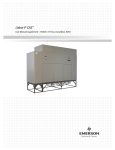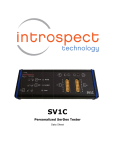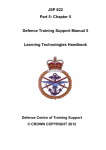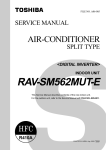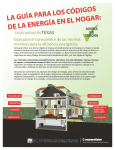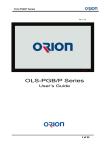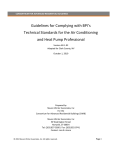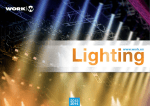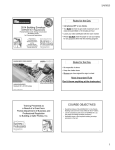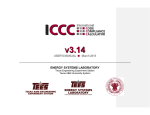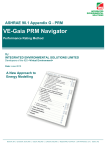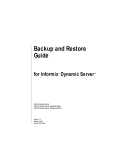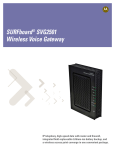Download North Carolina Energy Code Future of Commercial Requirements
Transcript
North Carolina Energy Code Future of Commercial Requirements 2008 North N th Carolina C li E Energy St Star C Conference f Conducted by: Appalachian State University Dept. of Technology & Energy Center Boone, NC Jeff Tiller, Tiller PE, PE [email protected] Chris Mathis and Associates Asheville, NC Margie Meares, [email protected] Total Energy Use by Sector (TBtu) 3000 Transporportation 27% Transportation Industrial R id ti l Residential Commercial 2500 Commercial 20% 2004 2000 1500 Industrial 27% 1000 Transpor - tation 28% 500 Com Commercial 7% 1960 20 00 19 90 19 80 19 70 0 19 60 Residential 26% Industrial 36% Residential 29% Two Sets of Requirements q – multiple pathways to compliance p • Building Design for All Commercial Buildings – Chapter p 7 -- ASHRAE 90.1-2004 in the North Carolina energy code • Design g by y Acceptable p Practice for Commercial Buildings – Chapter 8 – part of the IECC 2004 – with local amendments 1/28/2008 Mathis Consulting Company Page 3 Energy Consumption in Commercial Buildings • More than half of energy use is for HVAC and lighting • Energy bill equals 25% of total operating costs • Climate sensitive design and d off-the-shelf ff th h lf technologies can cut energy bill by 50% Typical Commercial Building Energy p Patterns Consumption Other Equip Equip. Misc Cooking Refrgd'n Refrgd n Lighting HVAC Water Htg 1/28/2008 Mathis Consulting Company Page 5 Chapter 7 Æ ASHRAE 90.1 The BIG chapter… www ASHRAE org www.ASHRAE.org 701.1 Scope. p Commercial buildings g shall meet the requirements of ASHRAE/IESNA 90.1. Exception: Commercial buildings that comply with Chapter 8. Referenced Standards ASHRAE 90.1—2004 Energy Standard for Buildings Except LowRise Residential Buildings 1/28/2008 Mathis Consulting Company Page 6 Organization of ASHRAE Standard 90 90.1 1-2004 2004 1 Purpose 7 Service Water Heating 2 Scope 8 Power 3 Definitions g g 9 Lighting 4 Administration and Enforcement 10 Other Equipment 5 Building Envelope 11 Energy Cost Budget Method 6 Heating Heating, Ventilating Ventilating, and Air-Conditioning 12 Normative References 1/28/2008 Mathis Consulting Company Page 7 High Rise Residential – Which Energy Code? Key Concepts Section 5 – Envelope • Building envelope d does nott use energy • Design affects heating and cooling loads • Insulation affects the temperature of inside surfaces; comfort • Daylighting can reduce electric lighting 1/28/2008 Mathis Consulting Company Page 9 Section 5 – Envelope, cont’d • Integrated g design g approach pp saves energy gy • Building envelope requirements address: – Opaque elements • Roofs, walls, floors, below-grade walls, slabs, opaque doors – Fenestration • Windows, doors, skylights • How often do we get the chance to get this part of the building right? 1/28/2008 Mathis Consulting Company Page 10 Section 5 Envelope Compliance Methods Section 5.2 Mandatory Provisions Prescriptive Option Trade-Off Option Energy Cost Budget Compliance p 1/28/2008 Mathis Consulting Company Page 11 502.3 Basic Requirement: Air Leakage Building Envelope Sealing Caulk around penetrations of chimney flue vents or attic hatches Caulk between wall panels particularly at corners and changes in orientation Caulk around doors and windows Caulk between wall arch floor where floor penetrates wall Caulk between wallll and d rooff Caulk between wall panels and top and bottom plates in exterior walls Weatherstrip doors Caulk between wall and foundation Caulk at penetrations of utility services or other service entry through walls floors and roofs Major Air Leakage Sites • • • • • • • Cavities above suspended p ceilings g Plenum return spaces (Highly depressurized) Ventilated walls Equipment tunnels and chases Mechanical rooms and mezzanines Unconditioned adjacent space (Storage, warehouse, plant, etc.) Exhaust and ventilation fans, plus wind and stack effect effect, are major driving forces •Return Plenum Problems - Canopy Is Air Barrier Continuous? • • • • Brand-new NC building Drywall left off of exterior wall above dropped ceiling Building uses above-ceiling area as return When HVAC operates operates, entire wall all ca cavity it goes to a negati negative e pressure, increasing air leakage, effectively reducing insulation value, and potentially causing moisture problems Limiting Air Leakage Pathways • • • • Materials and connections must: stop air flow withstand jobsite abuses withstand forces of wind and pressure Penetrations must be sealed p plumbing, g, wiring, g, communications ductwork windows and doors F Functional i l penetrations, i such h as air i intakes for exhaust fans, must be dampered Vestibules (5 Stories or more, with exceptions) Section 5 – Envelope -- Vestibules Required q at building g entrances Self closing doors Exceptions: a. Building entrances with revolving doors. b. Doors not used as a building entrance. c. Doors D opening i di directly l ffrom a dwelling d lli unit. i d. Building entrances in buildings located in climate zone 1 or 2. e. Building entrances in buildings located in climate zone 3 or 4 that are less than four stories above grade and less than 10,000 ft2 in area. f. Building entrances in buildings located in climate zone 5, 6, 7, or 8 that are less than 1,000 ft2 in area. g. Doors D th t open di that directly tl ffrom a space that th t is i lless th than 3,000 ft2 in area and is separate from the building entrance. 1/28/2008 Mathis Consulting Company Page 17 Section 5 - Prescriptive Requirements Building Envelope Requirements, Ventilated Attic Semiheated g Storage Conditioned Space Ventilated Crawlspace Unconditioned Space Exterior Envelope Semi-Exterior Envelope 1/28/2008 Mathis Consulting Company Page 18 U-Factors • The amount of heat in Btus (British thermal units) that flows each hour through one square foot, when there is a 1ºF temperature difference across the surface • The smaller the number the better 1 U - Factor F t = R -Value 1/28/2008 Mathis Consulting Company Page 19 Common R-values – Resistance to Conductive Heat Flow Concrete ½” Drywall Double-paned glass Low-e glass Fiberglass insulation Cellulose insulation Expanded polystyrene Extruded polystyrene Icynene foam Polyurethane foam 0.2 per inch 0.5 1.8 about 3.0 3 to 4 per inch 3.7 per inch 4 per inch 5 per inch 3.6 to 3.7 per inch 6.7 to 7.0 per inch Steel Framing and Insulation 1/28/2008 Mathis Consulting Company Page 21 Thermal Losses from Steel Stud Walls U-factors for Metal Stud Walls Nominal R-value Effective R-value U-factor Continuous Insulated Sheathing 1/2 EPS 5/8 1/2" 5/8" Poly-Iso Poly Iso 1 1" XPS R-2.0 R-4.0 R-5.0 2 x 4 Metal Framing at 16 inches on Center (3.5 in cavity depth) None (0 0) (0.0) 03 2 0.352 0 20 0.207 0 146 0.146 0 128 0.128 R-11 (5.5) 0.132 0.105 0.087 0.080 R-13 (6.0) 0.124 0.100 0.083 0.077 R-15 (6.4) 0.118 0.096 0.080 0.074 2 x 4 Metal Framing at 24 inches on Center (3.5 in cavity depth) ((6.6)) 0.116 0.094 0.079 0.073 R-11 R-13 (7.2) 0.108 0.089 0.075 0.070 R-15 (7.8) 0.102 0.084 0.072 0.067 Effective R-value of 2x4 Metal Framed Walls (16” (16 o.c.) oc) 20 18 16 14 12 10 8 6 4 2 0 R-15 R 15 R-13 R-11 None Effective R-Value of 2x4 Metal Framed Wall with R13 Batt Insulation Sheathing OSB/ Drywall 1/2" XPS 1/2" Poly-Iso 1" XPS 2" XPS R-0.5 R-2.5 R-3.4 R-5.0 R-10.0 OSB/ 1/2" XPS 1/2" P Polyl 1" XPS Drywall Iso 2" XPS R-value 8.1 95 9.5 11.5 12.5 17.5 Above Grade Floors – Is the Insulation Missing? • • • • Continuous insulation is the key 1” of foam is vital for exposed slab edges Heat loss will be more than th just j t 4” of missing insulation Trace other potential discontinuities in wall insulation system Make Insulation Continuous • • • Block walls -- should be insulated; insulating cores very ineffective Floors over unheated spaces, such as parking areas, need insulation For discontinuities in walls, such as offset areas for stairwells, elevators, and other spaces, the exterior envelope l mustt b be d determined. t i d Th The envelope requires both insulation and air sealing. 2006 IECC Climate Zones: Zones 4 and Below Don’t Require Wall Vapor Barriers (Only NW Mountains need one) 2009 NCECC •5 •4 •3 Roof Insulation Requirements: IECC 2003 ((Chapter 8 of current code) IECC (Chapter 8): Roof Insulation Requirements Maximum Glazing Area 10% 25% 40% Cavity Continuous Cavity Continuous Cavity Continuous Insulation Insulation Insulation Insulation Insulation Insulation All-wood joist/truss Metal joist/truss Concrete slab or deck Metal purlin with thermal block Metal purlin without thermal block 50% Cavity Continuous Insulation Insulation R-19 R-14 R-19 R-16 R-25 R-19 R-25 R-19 R-19 R 19 NA R-15 R 15 R-14 R-25 R 25 NA R-17 R 17 R-16 R-25 R 25 NA R-20 R 20 R-19 R-25 R 25 NA R-20 R 20 R-19 R-25 R-15 R-25 R-17 R-30 R-20 R-30 R-20 X R 15 R-15 X R 17 R-17 X R 20 R-20 R 30 R-30 R 20 R-20 Roof Insulation Requirements: ASHRAE 90.1-2004 (Chapter 7 of current code and d Chapter Ch t 5, 5 section ti 501 off new code) d ) Table 5.5-3 ASHRAE 90.1-2004 Nonresidential Residential Semiheated ASHRAE 90 90.1-2004 1 2004 (Ch (Chapter t 5) Nonresidential Roof Insulation Entirely above Deck Metal Building Attic and Other Zone 3 R-15 c.i.* R-19.0 R-30.0 Zone 4 R-15 c.i.* R-19.0 R-30.0 Zone 5 R-15 c.i.* R-19.0 R-30.0 Residential Roof Insulation Entirely above Deck Metal Building Attic and Other Zone 3 R-15.0 c.i. R-19.0 R-38 R 38.0 0 Zone 4 R-15.0 c.i. R-19.0 R-38 R 38.0 0 Zone 5 R-15.0 c.i. R-19.0 R-38 R 38.0 0 Semiheated Roof Zone 3 Insulation Entirely above Deck R-4 0 c R-4.0 c.i. i Metal Building R-10.0 Attic and Other R-13.0 * c.i. = continuous insulation -- typically foam Zone 4 R-4 0 c R-4.0 c.i. i R-10.0 R-13.0 Zone 5 R-5 0 c R-5.0 c.i. i R-10.0 R-19.0 Roof Insulation Requirements: IECC 2003 (Chapter 8 of current code) Roofs Insulation entirely above deck Metal buildings (with R-5 thermal blocks) Attic and other Climate Zone 3 4 5 R-15 cc.i. R-15, i R-15, R-15 cc.i. i R-20, R-20 cc.i. i R-19 R-19 R-19 R-30 R-30 R-30 Roofs for Metal Buildings: R-19 + R-10 Filled cavity roof -- Thermal blocks are a minimum, R-5 of rigid insulation, which extends 1 in. beyond the width of the purlin on each side, perpendicular p p to the p purlin. This construction is R-10 insulation batts draped p perpendicularly over the purlins, with enough looseness to allow R-19 batt to be laid above it, parallel to the purlins. Thermal blocks are then placed above the purlin/batt, and the roof deck is secured to the purlins. In the metal building industry this is known as the “sag industry, sag and bag bag” insulation system. system R-19: Standing seam with single insulation layer. Thermal blocks are a minimum R-5 of rigid insulation, which extends 1 in. beyond the width of the purlin on each side, perpendicular to the purlin purlin. This construction R R-19 19 insulation batts draped perpendicularly over the purlins. Thermal blocks are then placed above the purlin/batt, and the roof deck is secured to the purlins. Building Envelope Example: Roofs No longer counts: Batts over suspended p ceiling g tiles Inspection p is Critically y Important! p • • Insulation specification was R-30 foam on roof deck according to the plans l ((and d HVAC design) The 2.5 2 5 inches found installed in the field would only provide about R-15 2 ” 2.5” Commercial Wall Requirements: ASHRAE 90.1-2004 (Chapter 7 of current code and Ch t 5 Chapter 5, S Section ti 501 off new code) d ) Nonresidential Walls, Above Grade Mass Metal Building Steel Framed Wood Framed and Other Below Grade Wall Zone 3 Zone 4 Zone 5 R-5.7 R-5 7 cc.i.i R-13 R-13 R-13 NR R-5.7 R-5 7 cc.i.i R-13 R-13 R-13 NR R-7.5 R-7 5 cc.i.i R-13 R-13 + R-4 c.i. R-13 NR Residential Walls, Above Grade Mass Metal Building Steel Framed Wood Framed and Other Below Grade Wall R-7.3 c.i. R-13 R-13 + R-4 c.i. R-13 NR R-10 c.i. R-13 R-13 + R-7 c.i. R-13 NR R-11 c.i. R-13 + R-13 c.i. R-13 + R-7 c.i. R-13 NR Semiheated Walls, Above Grade Mass Metal Building Steel Framed Wood Framed and Other Below Grade Wall NR R6 R-6 NR R-13 NR NR R 10 R-10 R-13 R-13 NR NR R 11 0 R-11.0 R-13.0 R-13.0 NR Commercial Wall Insulation Requirements: IECC 2006 (Chapter 5 of new code) Walls, Above Grade Mass Metal building Metal framed Wood framed and other Walls, Below Grade 3 R-5 7 cc.i.i R-5.7 R-13 R-13 R-13 R 13 NR Climate Zone 4 5 R-5 7 cc.i.i R-5.7 R-7 6 cc.i.i R-7.6 R-13 R-13+R-13 R-13 R-13+R-3.8 c.i. R-13 R 13 R-13 R 13 NR NR g Walls for Metal Buildings: R-13 Single insulation layer: The first layer of R-13 insulation batts is installed continuously perpendicular to the girts and is compressed as the metal skin is girts. attached to the g R-13 + R-13 Double insulation layer: The first layer of R-13 insulation batts is installed continuously perpendicular to the girts, and is compressed as the metal skin ki iis attached tt h d tto th the gi girts. t Th The second d llayer off R R-13 13 iinsulation l ti b batts tt iis iinstalled t ll d within the framing cavity. 1/28/2008 Mathis Consulting Company Page 35 Typical? Non-Compliant! 1/28/2008 Mathis Consulting Company Page 36 How about now? 1/28/2008 Mathis Consulting Company Page 37 Commercial Floor Requirements: ASHRAE 90.1-2004 (Chapter 7 of current code and Chapter 5 5, Section 501 of new code) ASHRAE 90.1-2004 Nonresidential Floors Mass Steel Joist Wood Framed and Other Zone 3 Zone 4 Zone 5 R-6.3 R 63c c.i. i R-19 R-19 R-6.3 R 63c c.i. i R-19 R-19 R-8.5 R 85c c.i. i R-19 R-30 Slab-On-Grade Floors Unheated Heated NR R-7.5, 12 in. NR R-7.5, 24 in. NR R-10, 36 in. U-0.700 U 1 450 U-1.450 U-0.700 U 1 450 U-1.450 U-0.700 U 1 450 U-1.450 Opaque Doors Swinging Non Swinging Non-Swinging Residential Floors Mass Steel Joist Wood Framed and Other Zone 3 Zone 4 Zone 5 R-8.3 c.i. R 19 R-19 R-30 R-8.3 c.i. R 30 R-30 R-30 R-10 c.i. R 30 R-30 R-30 Slab-On-Grade Floors Unheated H Heated d NR R R-7.5, 24 iin. NR R 10 36 iin. R-10, NR R 10 36 iin. R-10, U-0.700 U-1.450 U-0.700 U-0.500 U-0.700 U-0.500 Opaque Doors Swinging Non-Swinging Commercial Floor Requirements: IECC 2006 ((Chapter p 5 of new code)) Floors M Mass Joist/ Framing Zone 3 R 5 c.i. R-5 i Zone 4 R 10 c.i. R-10 i Zone 5 R 10 c.i. R-10 i R-19 R-19 R-19 NR NR Slab-on-Grade Slab on Grade Floors Unheated slabs Heated slabs R-7.5 (12 in R-7.5 (12 in R-7.5 (24 in vert) vert) vert) Section 5 – Compliance Meet or exceed minimum R-values in Table 5.3 – Only R-value of insulation, not to include air films, etc. OR – Meet maximum U-factor, C-factor, or F-factor for the entire assembly OR – Perform area-weighted area weighted average U U-factor, factor CC factor, or F-factor 1/28/2008 Mathis Consulting Company Page 40 Glazing Area Percentage • Glazing percentage to Above Grade Wall – Gross window area / gross wallll area – Gross wall area includes • Above-grade walls • Band joist and subfloor between floors • Area of all doors and windows 1/28/2008 Section 802 Mathis Consulting Company Page 41 NFRC Label Section 802.2.3 1/28/2008 Mathis Consulting Company Page 42 IECC 2006 Commercial Glazing Requirements (new code) Vertical Fenestration (40% maximum of above-grade walls) Required U-factors Zone 3 Zone 4 Zone 5 Framing materials other than metal 0.65 0.4 0.35 Metal framed windows with or without thermal break Curtain Wall/ Storefront 0.6 0.5 0.45 Entrance Door 0.9 0.85 0.8 All Other 0.65 0.55 0.55 Solar Heat Gain Coefficient SHGC: Projection Factor <0.25 0.25 0.4 0.4 SHGC: 0.25 to 0.50 0.33 NR NR SHGC: >= 0.5 0.4 NR NR ASHRAE 90.1-2004 (Chapter 5) Fenestration Values for Climate Zone 3 WindowNonresidential Residential Wall Ratio 0-10.0% Uf ixed-0.57, SHGCall-0.39 Uf ixed-0.57, SHGCall-0.39 Uoper-0.67, SHGCnorth-0.49 10.1-20.0% Uf ixed-0.57, SHGCall-0.25 Uoper-0.67, SHGCnorth-0.49 20.1-30.0% Uf ixed-0.57, SHGCall-0.25 Uoper-0.67, 0 67 SHGCnorth-0.39 0 39 30.1-40.0% Uf ixed-0.57, SHGCall-0.25 Uoper-0.67, SHGCnorth-0.39 40.1-50.0% Uf ixed-0.46, SHGCall-0.19 Uoper p -0.47, SHGCnorth-0.26 Semiheated Uf ixed-1.22, SHGCall- NR Uoper-0.67, SHGCnorth-0.49 Uoper-1.27, SHGCnorth- NR Uf ixed-0.57, SHGCall-0.39 Uf ixed-1.22, SHGCall- NR Uoper-0.67, SHGCnorth-0.49 Uoper-1.27, SHGCnorth- NR Uf ixed-0.57, SHGCall-0.25 Uf ixed-1.22, SHGCall- NR Uoper-0.67, 0 67 SHGCnorth-0.39 0 39 Uoper-1.27, 1 27 SHGCnorth- NR Uf ixed-0.57, SHGCall-0.25 Uf ixed-1.22, SHGCall- NR Uoper-0.67, SHGCnorth-0.39 Uoper-1.27, SHGCnorth- NR Uf ixed-0.46, SHGCall-0.19 Uf ixed-0.98, SHGCall- NR Uoper p -0.47, SHGCnorth-0.26 Uoper p -1.02, SHGCnorth- NR ASHRAE 90.1 Fenestration Requirements for Climate Zones 3 and 4 Uf ixed = U-value of fixed windows; Uoper = U-value of operable windows SHGCall = Solar Heat Gain Coefficient of all windows SHGCnorth = Solar Heat Gain Coefficient of north windows Fenestration Values for Climate Zone 4 WindowNonresidential Residential Wall Ratio 0-10.0% Uf ixed-0.57, SHGCall-0.39 Uf ixed-0.57, SHGCall-0.39 Uoper-0.67, SHGCnorth-0.49 10.1-20.0% Uf ixed-0.57, SHGCall-0.39 Uoper-0.67, SHGCnorth-0.49 20.1-30.0% Uf ixed-0.57, SHGCall-0.39 Uoper-0.67, SHGCnorth-0.49 30 1 40 0% Uf ixed-0.57, 30.1-40.0% 0 57 SHGCall-0.39 0 39 Uoper-0.67, SHGCnorth-0.49 40.1-50.0% Uf ixed-0.46, SHGCall-0.25 Uoper-0.47, SHGCnorth-0.36 Semiheated Uf ixed-1.22, SHGCall- NR Uoper-0.67, SHGCnorth-0.49 Uoper-1.27, SHGCnorth- NR Uf ixed-0.57, SHGCall-0.39 Uf ixed-1.22, SHGCall- NR Uoper-0.67, SHGCnorth-0.49 Uoper-1.27, SHGCnorth- NR Uf ixed-0.57, SHGCall-0.39 Uf ixed-1.22, SHGCall- NR Uoper-0.67, SHGCnorth-0.49 Uoper-1.27, SHGCnorth- NR Uf ixed-0.57, 0 57 SHGCall-0.39 0 39 Uf ixed-1.22, 1 22 SHGCall- NR Uoper-0.67, SHGCnorth-0.49 Uoper-1.27, SHGCnorth- NR Uf ixed-0.46, SHGCall-0.25 Uf ixed-0.98, SHGCall- NR Uoper-0.47, SHGCnorth-0.36 Uoper-1.02, SHGCnorth- NR Note: ASHRAE 90.1-2004 is an option for the current and new codes Product Information and I t ll ti Installation (S ti 5.8) (Section 5 8) Insulation (5 (5.8.1) 8 1) – Not compressed – Substantial contact/supported – Recessed equipment if >1% – Not above suspended ceilings – Insulation needs to be protected 1/28/2008 Mathis Consulting Company Page 45 Organization of ASHRAE Standard 90 90.1 1-2004 2004 1 Purpose 2 Scope 7 Service Water Heating 3 Definitions 8 Power 4 Administration and E f Enforcement t 9 Lighting 10 Other Oth E Equipment i t 5 Building g Envelope 11 Energy gy Cost Budget Method 6 Heating, Ventilating, and Air Air-Conditioning Conditioning 12 Normative References 1/28/2008 Mathis Consulting Company Page 46 Section 6 – HVAC Key Concepts • Goal – a system which minimizes system l losses and d utilizes tili ffree h heating ti and d cooling li • Scope and Compliance Paths • Establish minimum equipment efficiencies • Establish a min. level of control for systems • Establish minimum levels of construction and insulation of systems. • Simplified Approach/Prescriptive Path • Submittals 1/28/2008 Mathis Consulting Company Page 47 Section 6 – HVAC Scope (6.1.1) (6 1 1) • New Buildings – Mechanical equipment & systems serving i HVAC needs d off new buildings b ildi • Additions – Same as new buildings – Exception – if served by existing systems need not comply except for any new equipment or systems • Alterations – – Replacement equipment – minimum efficiency only – New cooling for un-cooled spaces to comply – Alterations to cooling system not decrease economizer capability unless meets prescriptive requirements – New ductwork & piping to comply – Exceptions E ti – repairs, i refrigerant fi t change, h relocation, l ti space constraints 1/28/2008 Mathis Consulting Company Page 48 Section 6 – Simplified Approach Option • Limited to buildings that meet the following criteria – – – – – – – – – 1/28/2008 buildings b ildi with ith 1 or 2 stories t i buildings < 25,000 ft2 single-zone systems Unitary packaged or split system; air-cooled or evaporatively-cooled only; equipment efficiencies per tables Economizer if required Outside air requirements are less than 3000 CFM and less than 70% of airflow Manual changeover or dual set-point thermostat Heat pump supplementary control No reheat or simultaneous heating and cooling for humidity control Mathis Consulting Company Page 49 ASHRAE / IESNA 90.1-2004 Simplified Approach 1. Each system must serve a single zone zone. 2. Cooling shall be packaged or split lit system t either ith air i or evaporative cooled. 3 Economizers required in 3. certain circumstances. 4 H 4. Heating ti shall h ll b be packaged k d or split system heat pump, gas,, electric,, or hot water. g 1/28/2008 Mathis Consulting Company ASHRAE / IESNA 90.1-2004 Simplified Approach (cont.) (cont ) 5. Outside air requirements shall be less than 3 3,000 000 cfm and less than 70% of supply y or energy gy air quantity; recovery system. 6. Requires manual changeover or dual set point thermostat. 7 Wh 7. When possible, ibl h heat pump feature will always provide ea g heating. ASHRAE / IESNA 90.1-2004 Simplified Approach (cont.) (cont ) 8. No reheat or simultaneous heating and cooling. 9 Control for systems 9. larger than 65,000 Btuh and ¾ HP fan motor require i a ti time clock. l k 10. Piping insulation and weather protection. protection 11. Ductwork and plenum insulation insulation. 1/28/2008 Mathis Consulting Company ASHRAE / IESNA 90.1-2004 Simplified Approach (cont.) (cont ) 12. Ducted systems air balanced to 10% of design. design 13. Separate thermostats interlocked to prevent simultaneous heating and cooling. 14 Exhausts over 300 cfm shall have 14. gravity or motor dampers. 15 System greater than 10,000 15. 10 000 cfm shall have optimum start controls. Condensation Challenges g • A/C ductwork: 50 50-65 65 0F • Cooling below 71 0F • Metal framing in winter • Metal framing g in summer • Cool piping for chilled water What Happened? Non-Code Compliant Example; 25-ton: Cooling Efficiency Cooling efficiency: 25 tons = 300 000 300,000 Btuh Example; 25 ton: Heating Heating efficiency: 25 tons = 300,000 Btuh Economizers in North Carolina • IECC 2003 Chapter 7 (ASHRAE 90.1): – Would be required in Asheville and high elevations • IECC 2003 Chapter 8: – Economizers required in all zones except 1,2,3b,5a and 6b (meaning all of North Carolina except p the coastal areas to Charlotte) Example; 25 ton: Duct Insulation Example; 25 ton: Ducts • Table 6-D in User Manual • R R-3.5: 3.5: 1 1-inch inch duct liner, fiberboard, duct board, flex duct; 1.5-inch mineral fiber duct wrap • R-6.0: 1.5-inch duct liner, fiberboard, duct board, flex duct; 2.5-inch flex duct, mineral fiber duct wrap • R-8.0: 2-inch duct liner, fiberboard, duct board, flex d t 3-inch duct; 3 i h fl flex d duct, t mineral i l fib fiber d ductt wrap • Duct Sealing Required (to be discussed later) Example; 25 ton: Other • Air Balancing – add note to the design drawings or specs calling for balancing according to ASHRAE 111, NEBB, AABCm or other industry-recognized industry recognized standard • Since no fan exceeds 300 cfm, a backdraft d damper iis nott required i d per 6 6.2.3.3.3 2333 ASHRAE / IESNA 90.1-2004 HVAC Mandatory y Provisions • Applies pp to the Prescriptive p Path and the Energy Cost Budget method • Requirements address address… – – – – – – Life cycle cost analysis Equipment efficiencies Load calculations Controls Construction and insulation Completion requirements Constant vs. Variable Speed Systems • Constant speed fans and pumps, constant temperature heating and cooling systems and constant volume ventilation and exhaust systems are efficient only at full load conditions. • Variable systems are efficient at part loads. • Motors: Multiple speed, modular, variable speed. • Supply Air: Bypass, variable air volume. • Supply temperature: Reset based on demand or outdoor air temperature. y • Outdoor air: Reset based on occupancy. • Primary heating and cooling equipment: staged, modular. Section 6 Mechanical Equipment Efficiency Section 6.4 • • • • Air conditioners & Condensing Units Heat Pumps Water Chilling Packages – standard conditions Packaged Terminal and Room Air Conditioners & Heat Pumps • Furnaces, F Duct D t Furnaces F and d Unit U it Heaters H t • Boilers • Heat Rejection Equipment 1/28/2008 Mathis Consulting Company Page 67 Section 6 Load Calculations • Load Calculations are required! – Ask A k ffor them! h ! 1/28/2008 Mathis Consulting Company Page 68 Section 9 – Lighting 1/28/2008 Mathis Consulting Company Page 69 Energy-Efficient Energy Efficient Lighting Sources Lighting Power Densities Using the Building Area Method Building Area Type a Automotive Facility Convention Center Court House Dining: Bar, Lounge/ Leisure Dining: Cafeteria/ Fast Food Dining: Family Dormitory Exercise Center Gymnasium Hospital/Health Care Hotel Library Manufacturing Facility Motel Motion Picture Theater Lighting g g Power Density (Watt/ft2) 1.5 1.4 14 1.4 1.5 1.8 1.9 15 1.5 1.4 1.7 1.6 17 1.7 1.5 2.2 2.0 16 1.6 Office Parking Garage Penitentiary Performing Arts Theater Police/Fire Station Post Office Religious Building Retail School/University Sports Arena Town Hall Transportation Warehouse 1.3 0.3 1.2 1.5 1.3 1.6 2.2 1.9 15 1.5 1.5 1.4 1.2 12 1.2 Does the Building Comply? • Determine the total connected power in watts for the proposed lighting • Determine the interior lighting power budget for the entire building or space • Building complies if: – Interior I t i lighting li hti power b budget d t - total t t l connected t d power 0 Exterior Lighting • Criteria – Lighting power supplied through building electrical service – Must use energy energy-efficient efficient lighting sources to highlight paths, walkways and parking areas • 45 Lumens/Watt • Fluorescent or Compact Fluorescent • Metal Halide or High Pressure Sodium • Exceptions • • • • Historical Safety Signage Emergency •Section 805.5/805.6 Section 11 Energy Cost Budget Method • Alternative to prescriptive method except buildings with ith no mechanical h i l systems t • Based on overall building performance expressed as “energy cost budget” • Mandatory Provisions all must be met • Budget (or baseline) based on prescriptive measures • Allows trade-offs between measures • Useful for optimizing design 1/28/2008 Mathis Consulting Company Page 74 So, What Now? • In Commercial, A Appendix di B iis not enough • Plan review and inspection of energy features is needed 1/28/2008 Mathis Consulting Company Page 75 Key Inspection Points • Envelope – Insulation I l i values l correct? ? P Proper iinstallation? ll i ? – Fenestration -- % glass – Fenestration – U U-factor factor and SHGC (on plans and in field) – Air sealing details • HVAC – Programmable controls? – Economizer? E i ? – Duct and pipe insulation? – Ducts ucts sea sealed? ed 1/28/2008 Mathis Consulting Company Page 76 Key Inspection Points (cont.) • HVAC (continued) – No simultaneous heating and cooling (except where allowed for reheat) – Complex systems • • • • • Fan power Temperature reset Zoning Reheat limitation Etc Etc. • Lighting – If most lamps p are not T-8 fluorescent or more efficient lamps, need to check – Check controls – Exit signs – Exterior lighting 1/28/2008 Mathis Consulting Company Page 77 ASHRAE 90.1: Advanced Design Guide – Office Building ASHRAE 90.1 2004 Z Zone 4 R-15 c.i.* R-19.0 R-30 0 R-30.0 Advanced Design Guide Z Zone 4 R-20 c.i.* R-13 + 19 R-38 Walls, Above Grade Mass Metal Building Steel Framed Wood Framed and Other Below Grade Wall R-5.7 c.i. R-13 R-13 R-13 NR R-11.4 c.i. R-13 R-13+R-7.5 R-13 NR Floors Mass Steel Joist Wood Framed and Other R-8.3 R 8 3 cc.i. i R-30 R-30 R-8.3 R 8 3 cc.i. i R-30 R-30 Rooff R Insulation Entirely above Deck Metal Building Attic and Other ASHRAE 90.1: Advanced Design Guide – Office Building Fenestration Values for Climate Zone 4 WindowWindow ASHRAE 90.1 2004 Wall Ratio 0-10.0% 10.120.130.140 1 40.1- Advanced Design Guide Ufixed-0.57, SHGCall-0.39 Up to 40% of wall area Uoper-0.67, SHGCnorth-0.49 U-0.42 Ufixed-0.57, SHGCall-0.39 SHGC - 0.46 Uoper-0.67, SHGCnorth-0.49 Area of north glass * SHGCn + Ufixed-0.57, SHGCall-0.39 Area of south glass * SHGCs > Uoper-0.67, 0.67, SHGCnorth-0.49 0.49 Area of east glass * SHGCe + Ufixed-0.57, SHGCall-0.39 Area of west glass * SHGCw Uoper-0.67, SHGCnorth-0.49 South, east, west has overhang Ufixed-0.46, 0 46 SHGCall-0.25 0 25 Uoper-0.47, SHGCnorth-0.36 ASHRAE 90.1: Advanced Design Guide – Office Building Interior Lighting ASHRAE 90.1 2004 1.30 Watts/. Sq ft Advanced Design Guide 0.90 Watts/ sq ft 90 lumen/ watt linear fluorescent Dimmable fixture within 12 ft of N/S window wall or within 8 ft of skylight edge Auto-off in all unoccupied rooms Reflectance of 80% on ceilings, 70% on walls and vertical partition ASHRAE 90.1: Advanced Design g Guide – Office Building g Cooling ASHRAE 90.1 2004 Advanced Design Guide 0-65 kBtuh 65 135 kBt 65-135 kBtuh h 135-240 kBtuh > 240 kBtuh 10 SEER 10 3 EER/ 11 10.3 11.2 2 IPLV 9.7 EER/ 11.2 IPLV 9.5 EER/ 11.2 IPLV 13 SEER 11 EER/ 11.4 11 4 IPLV 10.8 EER/ 11.2 IPLV 10 EER/ 10.4 IPLV Furnaces All sizes 80% AFUE 80% AFUE Heat pumps 0-65 kBtuh 65-135 kBtuh >135 kBtuh 10 SEER/ 6.8 HSPF 10.1 EER 9.3 EER/ 9.2 IPLV (>240) 13 SEER/ 7.7 HSPF 10.6 EER/ 11 IPLV 10.1 EER/ 11 IPLV Economizers -- depend Ventilation controls optional p Sealed ducts Economizers > 54 kBtuh Motorized control with CO2 sensors Sealed ducts 81% gas instantaneous water htr EF > 99% Other ASHRAE 90.1: Advanced Design Guide – Office Building ASHRAE 90.1 2004 Z Zone 4 R-15 c.i.* R-19.0 R-30 0 R-30.0 Advanced Design Guide Z Zone 4 R-20 c.i.* R-13 + 19 R-38 Walls, Above Grade Mass Metal Building Steel Framed Wood Framed and Other Below Grade Wall R-5.7 c.i. R-13 R-13 R-13 NR R-11.4 c.i. R-13 R-13+R-7.5 R-13 NR Floors Mass Steel Joist Wood Framed and Other R-8.3 R 8 3 cc.i. i R-30 R-30 R-8.3 R 8 3 cc.i. i R-30 R-30 Rooff R Insulation Entirely above Deck Metal Building Attic and Other Corners 1/28/2008 Mathis Consulting Company Page 85 Wall Insulation Zone 11a: Wall Insulation Requirements (NC 2006 Code -- Chaper 8) Wood W dF Framing i Metal Framing CMU with integral insulation Other masonry walls Maximum Glazing Area 10% 25% 40% 10% R 11 R-11 R 11 R-11 R 11 R-11 R 11 R-11 R-11 R-11 R-11 R-11 R-11/ R-5* R-11/ R-5* R-11/ R-5* R-11/ R-5* R 11 R-11 R 11 R-11 R 11 R-11 R 11 R-11 * R-11 metal or wood stud wall or R-5 continuous foam 1/28/2008 Mathis Consulting Company Page 86 Economizers (Simple) • Air economizers required on systems t if cooling li capacity: – > 90,000 Btu/h • Not required in climate zones: – 1, 1 2 2, 3b 3b,5a 5a or 6b • Not required if the cooling of proposed equipment meets or exceeds the EER listed in Table 803 2 6 803.2.6 Not required on system with air or evaporative cooling condensers and which serve spaces with open case refrigeration or that require filtration equipment in order to meet the minimum ventilation requirements of Chapter 4 of IMC. • Zone 7 >135,000Btu/h 1/28/2008 Section 803.2.6 Mathis Consulting Company Page 87 Economizers (Simple) • Trade-off high g cooling g efficiency y for economizer – Total cooling capacity – Climate zones Table 803.2.6 – Equipment efficiency (EER) Total Cooling Capacity of Equipment Building Location Zones 6a, 9a, 10a, 11a, 12a, 12b,, 13a,, 13b,, 14a,, 14b,, 15-19 90,000 Btu/h to 134,999 Btu/h 135,000 Btu/h to 759,999 Btu/h 760,000 Btu/h or more 1/28/2008 Zones 3a, 3b, 4a, 7a, 8,, 9b,, 10b,, 11b Zones 4b, 5a, 5b, 6b,, 7b N/A 11.4 EER 10.4 EER N/A 10.9 EER 9.9 EER N/A 10.5 EER 9.6 EER Section 803.2.6 Mathis Consulting Company Page 88 Economizers (Complex) • In Accordance with Simple Requirements of Section 803.2.6 • Air economizers required on systems if cooling capacity: – > 90,000 Btu/h – > 65,000 65 000 Btu/h • Not required in climate zones: – 1, 2, 3b – 1, 2, 3b, 5a or 6b • Exception – Water economizers that can • cool supply pp y air by y either direct or indirect evaporation or both and • provide up to 100% of expected system cooling load at outside air temperatures of 50°F dry bulb/45°F wet bulb and below – Not required in systems under 135 135,000 000 Btu/h cooling capacity in climate zones 3c, 5b, 7, 13b, 14 Section 803.3.3.5 1/28/2008 Mathis Consulting Company Page 89 Air-Side Economizers • Use dampers to increase outside air when outside air cool system requires cooling 100% Outside Air 100% Exhaust Economizer co o e Ope Operation a o 55º F 80º F Outside air dampers are fully open. Maximum outside air is p provided 55º F Normal Operation Outside air dampers are positioned to provide the minimum outside air Section 803.2.6 1/28/2008 80º F Mathis Consulting Company Page 90 Water-Side Economizer “Strainer Cycle” 1/28/2008 Mathis Consulting Company Page 91 Shutoff Dampers (Simple and Complex) • Required for outdoor-air and exhaust systems t with ith d design i air i flflow rates t > 3000 cfm • Must automatically close during periods of non-use • Simple: Exceptions – Where restricted by health and life safety codes – Where serving areas designed for continuous operation – Systems y with readilyy accessible manual dampers Section 803.2.7/803.3.3.4 1/28/2008 Mathis Consulting Company Page 92 VAV Fan Control (Complex) • Individual fans with motors 25hp 25hp – Driven by a mechanical or electrical variable speed dd drive i – Be a vane-axial fan with variable pitch blades OR – Have controls or devices to result in fan motor demand 50% of their design wattage at 50% of design airflow when static pressure set point = 1/3 of the total design static pressure Section 803.3.3.6 1/28/2008 Mathis Consulting Company Page 93 Heat Rejection Equipment (Complex) New 2004 Requirement • Each fan powered by a motor 7.5 hp to – have capability to operate that fan at 2/3 of full speed or less – Have controls to automatically change the fan speed to control the leaving fluid temperature or condensing temperature/pressure of the heat rejection device • Exception p – Factory-installed heat rejection devices within HVAC equipment tested and rated in accordance with Tables 803.3.2(1) 803 3 2(1) through 803 803.3.2(3) 3 2(3) Section 803.3.3.8 1/28/2008 Mathis Consulting Company Page 94 Requirements for Multiple Zone Systems (Complex) • Systems shall be VAV systems that are d i designed d and d capable bl off b being i controlled t ll d tto reduce primary air supply to each zone to a minimum before reheating reheating, recooling or mixing takes place • Several exceptions Section 803.3.4 1/28/2008 Mathis Consulting Company Page 95 Duct and Plenum Insulation (Simple and Complex) • Required for supply and return ducts and plenums –L Located t d iin unconditioned diti d space - R5 – Located outside the building envelope - R8 • Exceptions p – Located within equipment – Design temperature difference between interior and exterior of duct or plenum > 15°F • D Ducts t designed d i d tto operate t att static t ti pressures > 3 in. wg to be leak tested in accordance with SMACNA • Complex: Furnish documentation that representative sections totaling at least 25% of the duct area have been tested and meet the requirements i Section 803.2.8/803.3.6 1/28/2008 Mathis Consulting Company Page 96 Duct Sealing (Simple and Complex) • Seal and securely fasten all joints joints, longitudinal and transverse seams and connections ti with: ith – – – – welds gaskets mastics mastic-plus-embedded fabric systems – Tapes • Duct tape is not permitted as a sealant on any metal ducts 1/28/2008 Section 803.2.8/803.3.6 Mathis Consulting Company Page 97 Pipe Insulation (Simple and Complex) • Thermally insulated according to Section 803.3.7 (complex system requirements refer to Table 803.3.7) 1/28/2008 Section 803.2.9/803.3.7 Mathis Consulting Company Page 98 Pipe Insulation Exceptions • Exceptions p – Factory-installed piping within equipment – Piping conveying fluids between 55°F and 105°F – Piping conveying fluids not heated or cooled l d th through h th the use off ffossilil ffuels l or electric power – Runout piping not exceeding 4 ft in length and 1 in. in diameter between the control valve and HVAC coil Section 803.2.9/803.3.7 1/28/2008 Mathis Consulting Company Page 99 HVAC System Completion (Complex) • Before issuance of certificate tifi t off occupancy – Air system balancing – Hydronic y system y balancing – Manuals Section 803.3.8 1/28/2008 Mathis Consulting Company Page 100 System Balancing (Complex) • Supply Air Outlets and Zone Terminal D i Devices – Must Have Means to Air Balance – Discharge Dampers Prohibited on Constant Volume and Variable Volume Fans with Motors > 25 Hp • Hydronic Systems – Individual Hydronic Heating and Cooling Coils to b E be Equipped i d with ith M Means ffor B Balancing l i and d Pressure Test Connections Section 803.3.8.1 1/28/2008 Mathis Consulting Company Page 101 Manuals (Complex) • O & M Manual Required – Contents • Equipment Capacity and Required Maintenance • Equipment E i O & M Manuals M l • HVAC System Control Maintenance and Calibration Information • Written Narrative of Each System Operation Section 803.3.8.3 1/28/2008 Mathis Consulting Company Page 102 Heat Recovery y for SWH • Condenser heat recovery required for h ti / h ti off SWH provided: heating/reheating id d – Facility operates 24 hours/day – Total installed heat capacity of water-cooled water cooled systems >6,000,000 Btu/hr of heat rejection – Design SWH load >1,000,000 Btu/h • The required heat recovery system shall have the capacity to provide the smaller of : – 60% of the peak heat rejection load at design conditions or – the preheating required to raise the peak service hot water draw to 85 degree F Section 803.3.9 1/28/2008 Mathis Consulting Company Page 103 Service Water Heating • Summary S off requirements i t – Heat traps to reduce standby losses – Pipe insulation to reduce distribution and standby losses – Circulation loop temperature controls to reduce distribution losses 1/28/2008Section 804 Service Water Heating Mathis Consulting Company Page 104 Typical yp Commercial Building g Energy gy Consumption Patterns Other Equip. Misc Cooking Refrgd'n Lighting HVAC Water Htg 1/28/2008 Mathis Consulting Company Page 105 Heat Traps • Required on noncirculating hot water systems Section 804.4 1/28/2008 Service Water Heating Mathis Consulting Company Page 106 Pipe Insulation • Noncirculating system q insulation requirements – First eight feet of outlet piping on systems with no integral g heat traps p – 1/2 inch of insulation required • Circulating systems – 1 inch of insulation Section 804.5 1/28/2008 Service Water Heating Mathis Consulting Company Page 107 Hot Water System Controls • Application: circulating hot water systems – Automatic time switches required to turn off the pump and heat tracer tape when it is not in use Section 804.6 1/28/2008 Service Water Heating Mathis Consulting Company Page 108 More Information • For additional training materials see www.energycodes.gov/training/presentation s.stm • Code Books: www.iccsafe.org 1/28/2008 Mathis Consulting Company Page 109 Commercial Energy Code Compliance Lighting Requirements Chapter 8 NCECC 1/28/2008 Mathis Consulting Company Page 110 Outline • Overview of Commercial Energy gy Codes • Code Requirements – Building Envelope • Mandatory Requirements • Prescriptive Requirements – Mechanical Systems • Simple Systems • Complex Systems – Service Water Heating – Lighting Systems 1/28/2008 Mathis Consulting Company Requirements for Chapter 7 (ASHRAE 90.1) are covered in a separate presentation Page 111 IECC Chapters 7 and 8 Commercial Building Compliance Options Scope Building Envelope Building Mechanical Systems Service Water Heating Systems Building Lighting Systems Total Building Performance Chapter 7 ASHRAE 90 1 90.1 Energy Standards for Buildings Except LowLow Rise Residential Buildings Chapter p 8 Design by Acceptable Practice for Commercial B ildi Buildings Section 2 Section 5 Section 6 (Simple Approach If Bldg < 25,000 s.f.) Section 7 Section 9 Section 10 Section 801 Section 802 (less than 50% glazing only) l ) Section 803 Section 804 Section 805 Section 806 1/28/2008 Mathis Consulting Company Page 112 IECC Chapter 8 Design by Acceptable P Practice ti Building System Compliance Options Prescriptive Option Envelope Lighting Mandatory Provisions ( q (required for all compliance options) Trade Off Option Energy Code Compliance Mechanical HVAC Performance Option SWH 1/28/2008 Mathis Consulting Company Page 113 Scope p • 805.1 General – Lighting system controls – Connection of ballasts – Max. interior lighting power – Min. acceptable exterior lighting equipment 1/28/2008 Mathis Consulting Company Page 114 Interior Lighting Compliance Mandatory Requirements Controls Switching and Interior Lighting Power Requirements The building complies if its total connected power is no greater than the interior lighting power. Total Connected Power (805.4.1) < Interior Lighting g g Power (805.4.2) Entire Building Partial Building 1/28/2008 Mathis Consulting Company Page 115 Interior Lighting Controls • Lighting controls required i d ffor each h area enclosed by ceiling height partitions • Switch locations – In view of lights – “On” or “off” indication f from remote t location l ti – Occupancy sensor Section 805.2.1 1/28/2008 Mathis Consulting Company Page 116 Interior Lighting Controls • Exceptions –E Emergency/security / it lighting – Stairway or corridor li hti ffor egress lighting Section 805.2.1 1/28/2008 Mathis Consulting Company Page 117 Additional Controls • Each area with mandatory controls must have: – Light reduction controls (805.2.2.1) – Automatic A t ti lilighting hti shutoff h t ff (805.2.2.2) – Guestrooms (805.2.2.3) • Exceptions – only 1 luminaire – an occupant occupant-sensing sensing device – corridors, storerooms, restrooms, or public lobbies Section 805.2.2 1/28/2008 Mathis Consulting Company Page 118 Bi-Level Switching Li ht R Light Reduction d ti Controls C t l • Areas that are required to have manual control shall also – Reduce connected lighting load uniformly by 50% for each space – Exceptions Section 805.2.2.1 1/28/2008 Mathis Consulting Company Page 119 Bi-Level Switching • Compliance Examples Example: Alternate Luminaries SS 1/28/2008 Mathis Consulting Company Page 120 Bi-Level Switching • Compliance Examples Example: Dimmer Control Option Example: Alternate Lamps (a/b) D SS Dimmer Switch 1/28/2008 Mathis Consulting Company Page 121 Automatic Lighting Shutoff • In buildings > 5000 ft2 – must have h automatic i control devices to u ct o e either t e o on function • Scheduled basis using time-ofday • Unscheduled basis by occupant intervention • In 2004 IECC requirement for spaces >250 ft2 in buildings larger than 5,000 ft2 Section 805.2.2.2 1/28/2008 Mathis Consulting Company Page 122 Occupant Override • Where automatic time switch control devices are installed i t ll d tto comply l with ith A Automatic t ti Lighting Shutoff, device shall be equipped with an override switching device that: – Readily accessbile – Located so that person using the device can see the lights or area controlled by the switch – Manually operated – Allows lighting to remain on for no more than 2 hours when an override is initiated – Controls an area <5,000 square feet • Some Exceptions Section 805.2.2.2.1 1/28/2008 Mathis Consulting Company Page 123 Holiday scheduling • If automatic time switch is installed: – Automatic holiday scheduling feature that turns off ff allll lloads d ffor att lleastt 24 h hours and d th then resumes to normally scheduled operation • Exceptions – Retail R il stores and d associated i d malls, ll restaurants, grocery stores, churches and theaters 1/28/2008 Mathis Consulting Company Page 124 Guest Rooms • Master switch required at entry $ $ $ $ $ St d d R Standard Room Suite Section 805.2.2.2 1/28/2008 Mathis Consulting Company Page 125 Exterior Lighting g g Controls • Automatic switching or photocell controls shall be provided for all exterior lighting not intended for 24 hour operation. • Automatic time switches shall have a combination – Seven-dayy and seasonal daylight y g p program g schedule adjustment – A minimum 4-hour power backup 1/28/2008 Mathis Consulting Company Page 126 Tandem Wiring Center to Center • Exceptions E ti – Luminaires with electronic high-frequency ballasts – Luminaires not on same switch controls or not in the same area Section 805.3 1/28/2008 Mathis Consulting Company Page 127 Exit Signs • Internally illuminated exitit signs i shall h ll nott exceed 5 Watts per side Section 805.4 1/28/2008 Mathis Consulting Company Page 128 Interior Lighting Power Requirements Mandatory Requirements Controls Switching and Interior Lighting Power Requirements The building complies if its total connected power is no greater than the interior lighting power. Total Connected Power < Interior Lighting g g Power Entire Building Partial Building 1/28/2008 Mathis Consulting Company Page 129 Total Connected Power • Total connected lighting wattage includes: – Lamp wattage – Ballast wattage • Sources of bulb/ballast wattages – Manufacturer’s literature – Industry default tables • Exceptions –S Specialized i li d medical, di l d dental, t l and d research h lilighting hti – Professional sports arena playing field lighting – Display lighting for gallery exhibits, museums, and monuments t – Guest room lighting in hotels, motels, boarding houses, or similar buildings – Emergency E li hti automatically lighting t ti ll off ff d during i normall building operation 1/28/2008 Mathis Consulting Company Page 130 Energy-Efficient Lighting Sources White LED 1/28/2008 Mathis Consulting Company Page 131 Interior Lighting Power Mandatory Requirements Controls Switching and Interior Lighting Power Requirements The building complies if its total connected power is no greater than the interior lighting power. Total Connected Power < Interior Lighting g g Power Entire Building • Entire building – Building is all one occupancy or a majority occupancy exists (Section 101.4.3) • Partial Building Tenant area or partial building – Use for tenant spaces in larger building or divide whole building into area types • Table 805.4.2/Table 805.5.2 Mathis Consulting Company 1/28/2008 Page 132 What is the Interior Lighting Power Budget for this Building? Office A: Office B: Bathrooms: Corridor: Retail A: Retail B: Future: 400 ft2 850 ft2 350 ft2 50 ft2 500 ft2 500 ft2 350 ft2 Office A Bathrooms Future F t Development Corridor Retail A Retail B Office B Total Building Area = 3000 ft2 1/28/2008 Mathis Consulting Company Page 133 Does the Building Comply? • Determine the total connected power in watts f the for th proposed d lighting li hti • Determine the interior lighting power budget for the entire building or space • Building g complies p if: – Interior lighting power budget - total connected power = 0 1/28/2008 Mathis Consulting Company Page 134 Exterior Lighting • Criteria – Lighting g gp power supplied pp through building electrical service – Must use energy-efficient lighting sources to highlight paths, th walkways lk and d parking ki areas • • • • • 45 Lumens/Watt Fluorescent Compact Fluorescent Metal Halide High Pressure Sodium • Exceptions E ti – Where approved because of the following considerations: • Historical • Safety Section 805.5/805.6 • Signage 1/28/2008 Mathis Consulting Company Page 135 Electrical Energy Consumption • In buildings having individual dwelling units, provisions shall be made to determine the electrical energy consumed by each tenant by separately metering individual dwelling units Section 805.7 805 7 1/28/2008 Mathis Consulting Company Page 136 Conclusion? • We can’t do it all in a day – Web W b resources – Future workshops – Plan review training – Worked examples • But we have to start somewhere! – Simple prescriptive techniques will be most common – Performance P f techniques t h i usually ll iinvolve l professionals with a license on the line • AIA,, PE,, etc. 1/28/2008 Mathis Consulting Company Page 137 Energy Consumption in Commercial B ildi Buildings M Matters! tt ! • M More than th h half lf off energy use is for g g HVAC and lighting • Typical energy bill equals q 25% of total operating costs • Climate sensitive design and off-theshelf technologies can cut energy bill by 50% 1/28/2008 Mathis Consulting Company Page 138 Additional Resources • www.thesciencebehind.com • www www.energycodes.gov/training/presentati energycodes gov/training/presentati ons.stm • http://www.energycodes.gov/training/pdfs /iecc com wb pdf /iecc_com_wb.pdf 1/28/2008 Mathis Consulting Company Page 139 Section 9.4.1.2 Occupancy Sensors • For high usage areas with irregular schedules • Applications – Private offices – Classrooms – Conference rooms – Break rooms – Restrooms 1/28/2008 Mathis Consulting Company Page 140 Section 9 Mandatory Provisions Exit Signs (section 9.4.3) 9 4 3) New Exit Sign S Requirements Internally illuminated exit signs shall not 90.1-2004, IECC 2003 exceed 5 watts per face. 1/28/2008 Mathis Consulting Company Page 141














































































































































